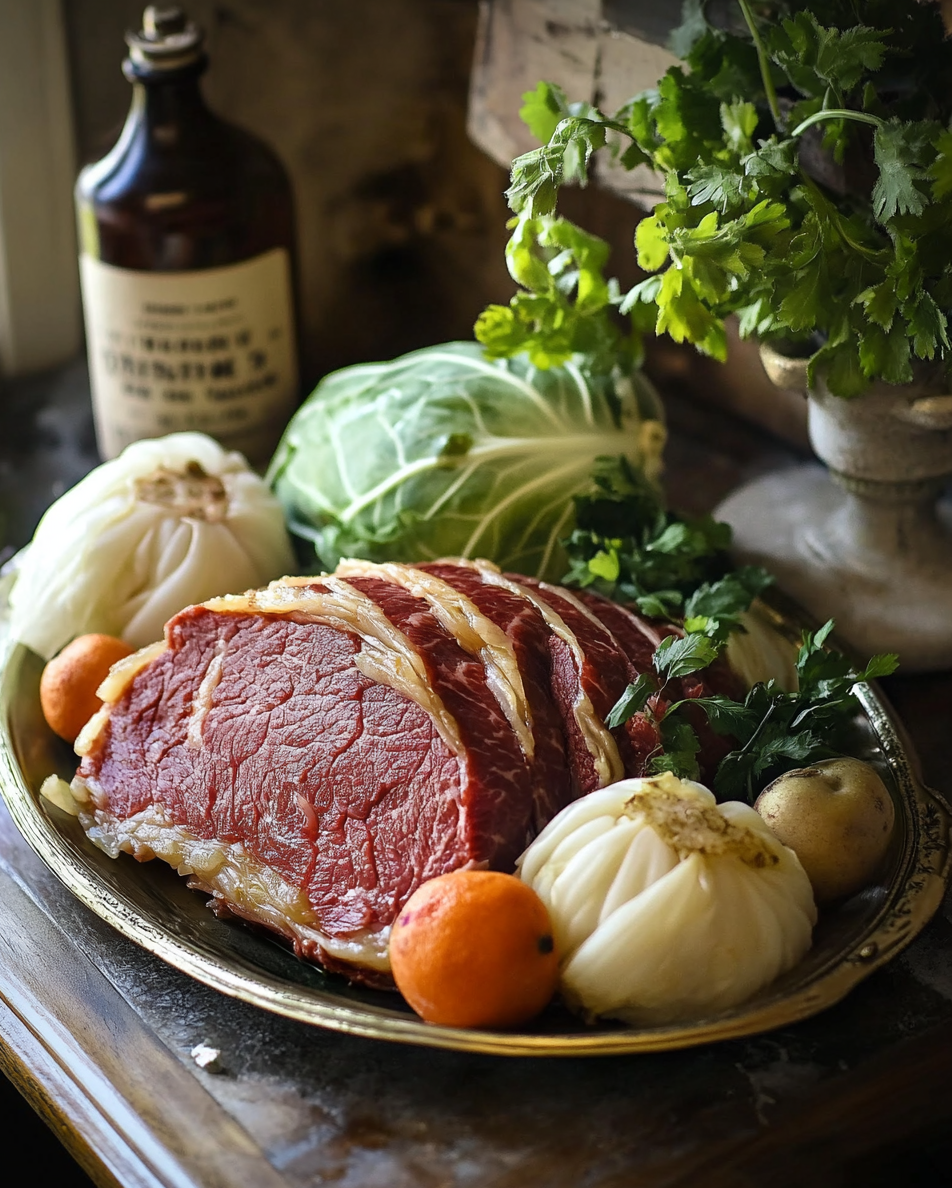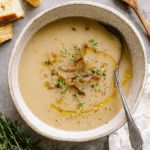Corned beef and cabbage is a classic dish, often associated with St. Patrick’s Day, but enjoyed year-round. This comforting and hearty meal features salt-cured beef brisket, which is boiled until tender, and served with vegetables like cabbage, red potatoes, and carrots. Its origins can be traced back to Irish-American immigrants who adapted traditional Irish dishes with ingredients available in the United States, leading to the pairing of corned beef and cabbage.
Full Recipe
Ingredients:
- 1 (3 to 4-pound) corned beef brisket with spice packet.
- 10 small red potatoes, halved
- 5 carrots, peeled and cut into 3-inch pieces
- 1 large head of cabbage, cut into small wedges
- 2 whole onions (optional, for added flavor)
- Water, to cover
- 1 can of beer (optional, for depth of flavor)
Additional Flavor Suggestions
- Spices: Corned beef usually comes with a spice packet, which includes a mix of mustard seeds, bay leaves, peppercorns, and other spices. This blend gives the beef its distinctive flavor.
- Beer: Adding a can of beer to the cooking water enhances the flavor, providing a rich and slightly bitter undertone that complements the saltiness of the beef.
- Onions: Including whole onions in the pot while simmering the corned beef adds subtle sweetness and depth to the broth.
Step-by-Step Cooking Process
- Prepare the Corned Beef: Rinse the corned beef brisket under cold water to remove excess salt. Place it in a large Dutch oven or stockpot and cover it with water. If using, add the beer and spice packet to the pot.
- Boil and Simmer: Bring the water to a boil, then reduce the heat to a simmer. Cover the pot and let the corned beef cook for about 2 to 2.5 hours, or until the meat is tender. Skim off any foam that rises to the surface.
- Add Vegetables: About 30 minutes before the corned beef is finished cooking, add the halved red potatoes and carrot pieces to the pot. Continue simmering until the vegetables are tender.
- Cook the Cabbage: In the last 15 minutes of cooking, add the cabbage wedges to the pot. Cook until they are just tender but not mushy.
- Rest and Slice the Corned Beef: Remove the corned beef from the pot and let it rest for about 15 minutes. This allows the juices to redistribute throughout the meat. Slice the corned beef against the grain into thin slices.
- Serve: Serve the corned beef slices with the vegetables and a ladle of the flavorful broth. For added flavor, spoon some of the cooking liquid over the meat and vegetables.
Flavor Profile
Corned beef and cabbage is a savory and hearty dish with a balanced flavor profile. The corned beef, with its salty and spiced seasoning, is rich and tender. The vegetables absorb the flavors of the broth, becoming soft and flavorful. The potatoes and carrots add a subtle sweetness, while the cabbage offers a mild, slightly bitter note that contrasts nicely with the saltiness of the meat.
Health Considerations
While corned beef and cabbage is a hearty and satisfying meal, it’s also important to be mindful of its nutritional aspects:
- Sodium Content: Corned beef is salt-cured, which means it contains a higher sodium content than fresh meats. For those watching their sodium intake, consider rinsing the corned beef brisket before cooking to reduce some of the saltiness.
- Protein and Iron: This dish is a good source of protein and iron, thanks to the beef. Iron is crucial for maintaining healthy blood cells and energy levels, making this a nourishing meal.
- Fiber and Vitamins: The cabbage and carrots in this dish provide dietary fiber, vitamins A, C, and K, and antioxidants. Cabbage, in particular, is known for its anti-inflammatory properties and is high in fiber, which aids in digestion.
- Balanced Meal: To make this meal more balanced, you can serve it with additional greens, such as a simple side salad, to increase the intake of fresh vegetables.
Tips for Perfect Corned Beef and Cabbage
- Don’t Rush the Simmering: The key to tender corned beef is slow simmering. Cooking the meat over low heat allows it to become tender and absorb the spices fully.
- Add Vegetables in Stages: Add the vegetables in stages to avoid overcooking. Potatoes and carrots go in first since they take longer to cook, followed by the cabbage towards the end.
- Slice Against the Grain: When slicing the corned beef, cut against the grain. This ensures tender slices that are easier to chew.
Nutritional Information
Corned beef and cabbage is a balanced meal that provides protein, fiber, and essential vitamins. However, it’s important to note that corned beef is relatively high in sodium due to the curing process. Here is an approximate nutritional breakdown per serving:
- Calories: Around 400-500 per serving, depending on the portion size
- Protein: High in protein from the beef
- Carbohydrates: Moderate, mainly from the potatoes and carrots
- Fiber: Cabbage and carrots provide a good amount of dietary fiber
- Vitamins and Minerals: Rich in vitamins C and K from the cabbage, potassium from the potatoes, and iron from the beef.
Using Leftovers Creatively
One of the great things about corned beef and cabbage is its versatility. Leftovers can be used in a variety of creative ways:
- Corned Beef Hash: Dice the leftover corned beef and vegetables and fry them together with onions and potatoes to make a classic corned beef hash. Top with a fried egg for a hearty breakfast.
- Sandwiches: Use slices of corned beef to make a Reuben sandwich. Layer the beef with Swiss cheese, sauerkraut, and Russian dressing between slices of rye bread, then grill until golden and crispy.
- Soups and Stews: Chop the leftover corned beef and vegetables into bite-sized pieces and add them to a pot of broth for a quick and easy corned beef and cabbage soup.
Origins and Cultural Significance
Corned beef and cabbage is a dish with roots in Irish-American culture. Although not a traditional Irish dish, it evolved in the United States in the 19th century. Irish immigrants in New York City adapted their native dish of bacon and cabbage by using corned beef from Jewish butchers, who were located in the same neighborhoods. The result was a flavorful, hearty meal that became synonymous with Irish-American cuisine, particularly around St. Patrick’s Day.
Serving Suggestions
Corned beef and cabbage is traditionally served with mustard or horseradish sauce to add a tangy kick. Serve it alongside Irish soda bread to complete the meal. The dish can be enjoyed on its own or with a side of mashed potatoes or roasted root vegetables.
Variations
- Slow Cooker Corned Beef: For a hands-off approach, cook the corned beef and vegetables in a slow cooker on low for 8-10 hours.
- Oven-Baked Corned Beef: After boiling, finish the corned beef in the oven for a crispy crust. Brush the cooked corned beef with a glaze made from mustard and brown sugar, then bake at 350°F for 15-20 minutes.
- Add a Twist: Incorporate different vegetables like parsnips, turnips, or sweet potatoes for a unique flavor.
Conclusion
Corned beef and cabbage is a timeless dish that marries simplicity with rich, comforting flavors. It’s a celebration of Irish-American heritage, often enjoyed as the centerpiece of a St. Patrick’s Day meal. With tender corned beef, flavorful broth-infused vegetables, and a touch of tradition, this dish offers a hearty and satisfying meal perfect for gatherings or a cozy family dinner. Whether you enjoy it with a splash of beer for added depth or stick to the classic preparation, corned beef and cabbage is sure to become a favorite comfort food in your culinary repertoire.






